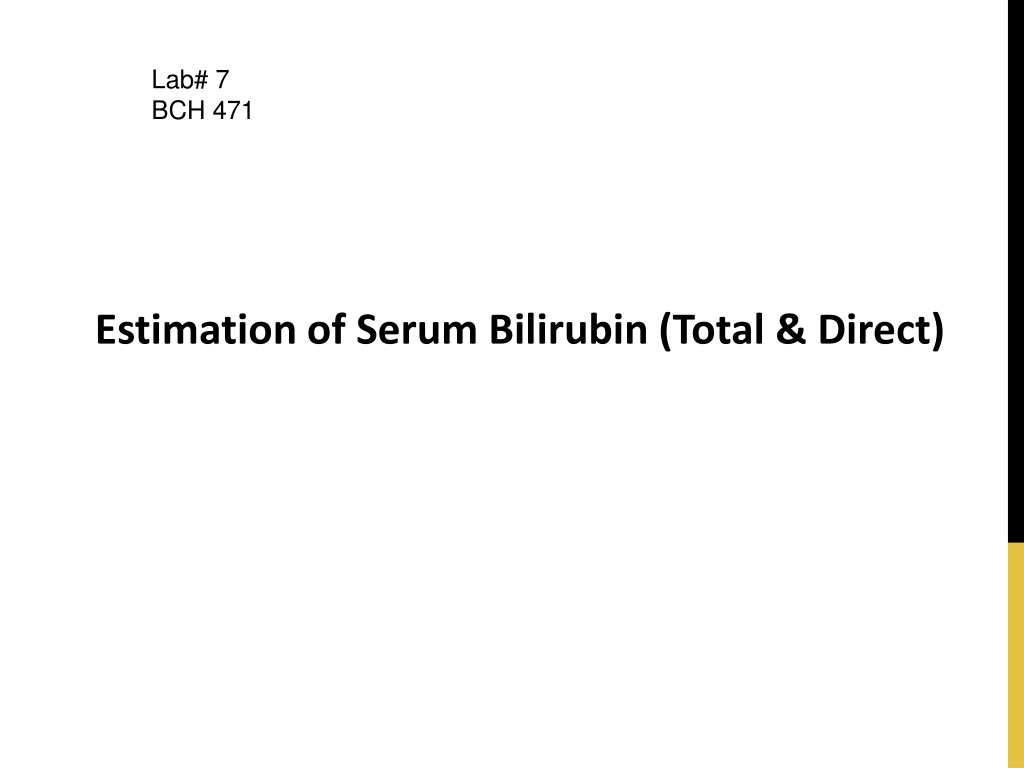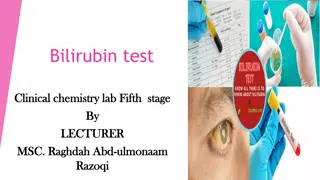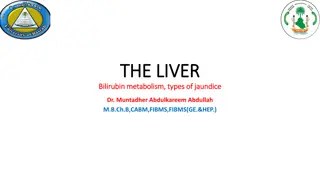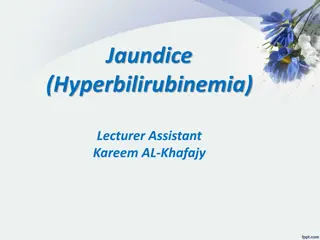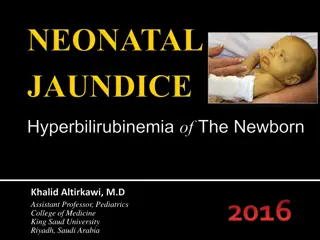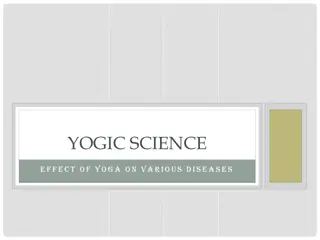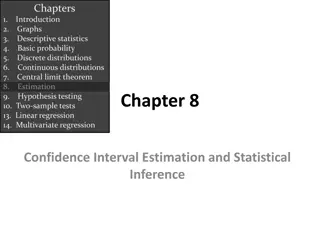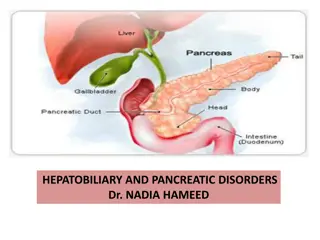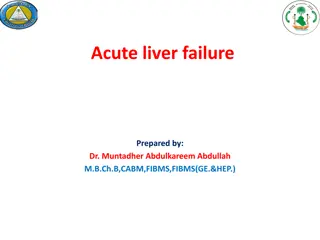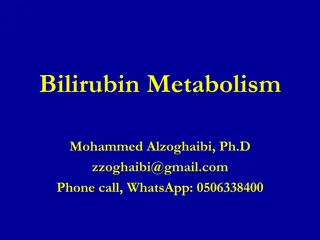Understanding Bilirubin: Estimation, Implications, and Causes of Jaundice
Bilirubin, a yellow compound in the catabolic pathway, plays a crucial role in health. Estimating serum bilirubin levels is key in diagnosing conditions like jaundice. Elevated levels, above 2 mg/dl, can indicate disease. Jaundice, characterized by skin and eye discoloration, has pre-hepatic, hepatic, and post-hepatic causes such as hemolysis, cirrhosis, and infections. Proper assessment and understanding are essential in managing bilirubin-related disorders.
Download Presentation

Please find below an Image/Link to download the presentation.
The content on the website is provided AS IS for your information and personal use only. It may not be sold, licensed, or shared on other websites without obtaining consent from the author. Download presentation by click this link. If you encounter any issues during the download, it is possible that the publisher has removed the file from their server.
E N D
Presentation Transcript
Lab# 7 BCH 471 Estimation of Serum Bilirubin (Total & Direct)
Objectives: 1-To estimate the amount of bilirubin in serum.
Bilirubin is a yellow compound that occurs in the normal catabolic pathway that breaks down heme
3 phases of Bilirubin Direct bilirubin: Conjugated with glucoronic acid Indirect bilirubin: unconjugated, insoluble in water Total bilirubin: sum of the direct and indirect of bilirubin. Notes: -Disturbances in the powers of conjugated and/or excretion of the liver of this yellow compound will lead to raised levels in serum.
Above about 2 mg/dl in the blood, leads to disease called Jaundice.
Bilirubin and jaundice Jaundice is caused by a build-up of bilirubin (yellow color) in the blood and tissues of the body. Jaundice is the discoloration of skin and sclera of the eye caused by high concentration of bilirubin.
The causes of jaundice may be classified as: Types of jaundice Pre-Hepatic Jaundice Hepatic Jaundice Post-Hepatic Jaundice -Cirrhosis of the liver Hemolytic disease Cholecystitis. -Infective Hepatitis -Neonatal Jaundice
1-PRE-HEPATIC JAUNDICE Hemolytic disease (excess hemolysis) The production of un-conjugated bilirubin may exceed the conjugating capacity of the liver and hence the serum levels of indirect (and of total) bilirubin will be raised and that of direct in the upper normal range or just a little elevated. The other liver function tests will usually give normal results
2-HEPATIC JAUNDICE Cirrhosis (in the absence of infection) Destruction of liver cells will lead to a reduced conjugating capacity with a: Raised serum level of indirect (and of total) bilirubin, with a low level of direct bilirubin and an abnormally high release, into the blood, of the enzymes: AST, ALT and ALP. Synthesizing power of liver will be diminished and hence low levels of total protein, albumin and cholesterol
2-HEPATIC JAUNDICE Hepatitis (in the presence of infection) The conjugative capacity of the liver is approximately normal, but there is the inability to transport the conjugated bilirubin from the liver cells to the biliary system, and it will be regurgitated back into the blood. Hence: The serum level of unconjugated bilirubin will be normal and that of conjugated (and total) bilirubin will be raised. Synthesizing power is diminished leading to low serum levels of proteins but the raising of antibodies to infection usually leads to raised total proteins level.
2-Hepatic Jaundice Neonatal Jaundice Conjugating enzymes in the liver are often absent at birth. Hence: Raised serum level of indirect (and total) bilirubin is to be expected Low level of direct bilirubin. The other liver functions are normal. The indirect bilirubin level will rise for the first few days after birth until the conjugating enzymes begin to synthesize.
3-POST-HEPATIC JAUNDICE Cholecystitis The bile duct is blocked. Hence: The indirect bilirubin level is normal but conjugated bilirubin is regurgitated into the blood and excreted into the urine (raised conjugated and total bilirubin). Enzymes will be regurgitated into the blood giving raised levels. The other liver function tests are normal
Normal unconjugated bilirubin (in blood) conjugated bilirubin (in blood) Normal unconjugated bilirubin (in blood) conjugated bilirubin (in blood) Hepatic Jaundice. (in the presence of infection) Post-Hepatic Jaundice (Cholecystitis) Pre-Hepatic, Hemolytic disease
Principle: Bilirubin in serum is coupled with diazotized sulphanilic acid to form azobilirubin . The water soluble conjugated bilirubin (direct bilirubin) reacts easily with reagents such as diazotized sulphanilic acid. while the water insoluble unconjugated bilirubin (indirect bilirubin) requires a solubilizing reagent, such as Caffeine, in order to react with the diazotized sulphanilic acid. In this experiment, the direct bilirubin is estimated in the absence of the solubilizing agent and then further bilirubin estimation in the presence of the solubilizing agent will give the total bilirubin level. The indirect or unconjugated bilirubin is then found by difference.
